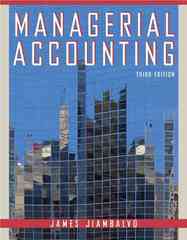Question
1) Exercise E2-2 Selected transactions for D. Reyes, Inc., an interior decorating firm, in its first month of business, are as follows. Jan. 2 Invested
1) Exercise E2-2 Selected transactions for D. Reyes, Inc., an interior decorating firm, in its first month of business, are as follows. Jan. 2 Invested $10,000 cash in the business in exchange for common stock. 3 Purchased used car for $4,000 cash for use in business. 9 Purchased supplies on account for $500. 11 Billed customers $1,800 for services performed. 16 Paid $200 cash for advertising. 20 Received $700 cash from customers billed on January 11. 23 Paid creditor $300 cash on balance owed. 28 Declared and paid a $1,000 cash dividend. Instructions For each transaction indicate the following. (a) The basic type of account debited and credited (asset, liability, stockholders? equity). (b) The specific account debited and credited (cash, rent expense, service revenue, etc.). (c) Whether the specific account is increased or decreased. (d) The normal balance of the specific account. Post journal entries to standard form of account. Use the following format, in which the January 2 transaction is given as an example. Account Debited Account Credited (a) (b) (c) (d) (a) (b) (c) (d) Basic Specific Normal Basic Specific Normal Date Type Account Effect Balance Type Account Effect Balance Jan. 2 Asset Cash Increase Debit Stock- Common Increase Credit holders? Stock Equity 2) Exercise E2-3 Data for D. Reyes, Inc., interior decorating, are presented in E2-2. Instructions Journalize the transactions using journal page J1. (You may omit explanations.) 3) E7-3 E7-3 Presented below are the assumptions, principles, and constraints discussed in this chapter. 1. Economic entity assumption 6. Matching principle 2. Going concern assumption 7. Full disclosure principle 3. Monetary unit assumption 8. Revenue recognition principle 4. Time period assumption 9. Materiality 5. Cost principle 10. Conservatism Instructions Identify by number the accounting assumption, principle, or constraint on page 323 that describes each situation below. Do not use a number more than once. (a) Is the rationale for why plant assets are not reported at liquidation value. (Do not use historical cost principle.) (b) Indicates that personal and business record-keeping should be separately maintained. (c) Ensures that all relevant financial information is reported. (d) Assumes that the dollar is the ?measuring stick? used to report on financial performance. (e) Requires that the operational guidelines be followed for all significant items. (f ) Separates financial information into time periods for reporting purpose. (g) Requires recognition of expenses in the same period as related revenues. (h) Indicates that market value changes subsequent to purchase are not recorded in the accounts. " 
Step by Step Solution
There are 3 Steps involved in it
Step: 1

Get Instant Access to Expert-Tailored Solutions
See step-by-step solutions with expert insights and AI powered tools for academic success
Step: 2

Step: 3

Ace Your Homework with AI
Get the answers you need in no time with our AI-driven, step-by-step assistance
Get Started


